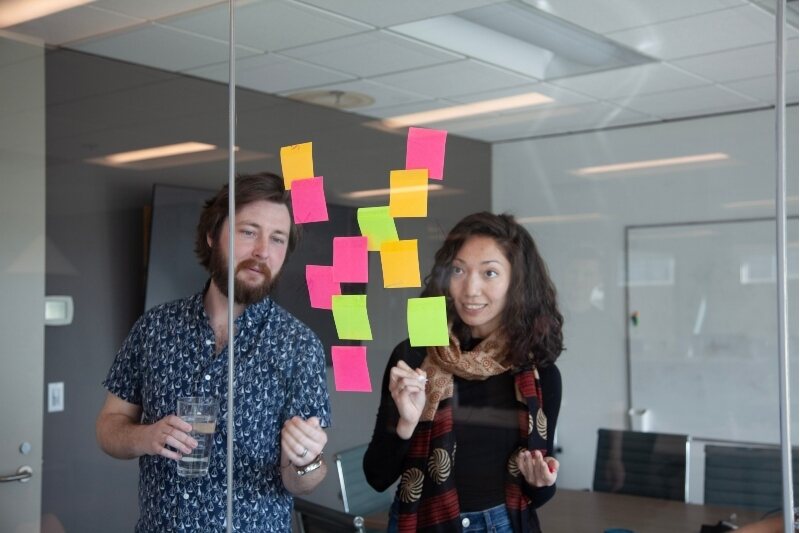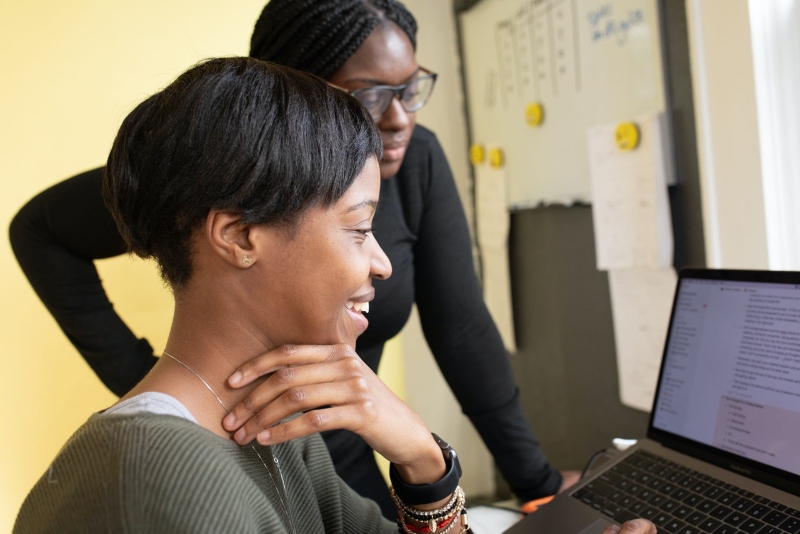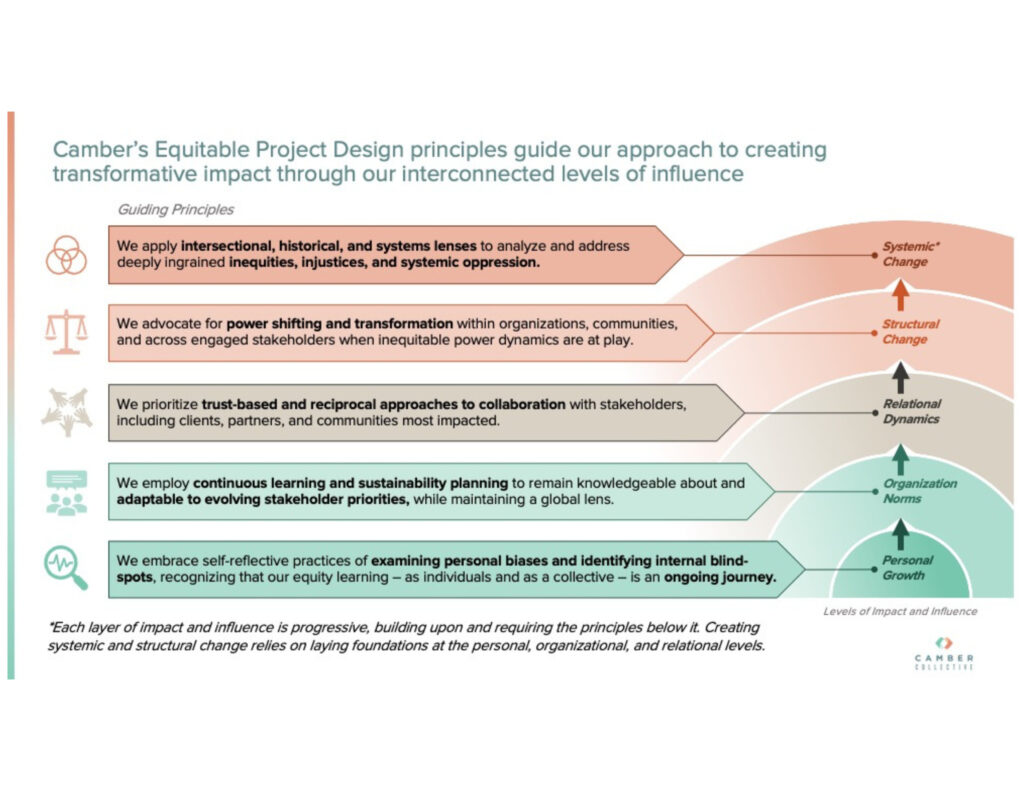Outset and Origin Story

The challenge Camber Collective faces, as a consultancy for an equitable and regenerative world, is how to build a project delivery model that reflects its equity-forward values. The firm’s journey began nearly a decade ago, when one of the founding Partners, Hope Neighbor, collaborated with the Hewlett Foundation to understand how women and families in Niger make decisions about, and access, family planning services and products.
Working with local partners, the Camber team interviewed local stakeholders: women, providers, and other community members to assemble a broad prism into 1) what was needed by the community and 2) how to design for holistic, sustainable, and community-relevant outcomes. This first-of-its-kind project led to a segmentation analysis and design of new programs enabling local community health workers and the Ministry of Health to better meet the needs of people and communities.
From this initial foray into equitable design, Camber’s approaches and methods have deepened. A central tenet of Camber’s evolving theory of impact is to build upon the opportunity — and indeed, necessity — to instill localization and co-creation while elevating the constituents and communities most impacted.

Key Principles and Considerations
Positioning constituents and communities as key thought partners and participants would allow Camber to engender deeper, more authentic, and sustainable practices, and further its progress towards key equity-forward principles first adopted by the firm in 2021.
Among these considerations were:
- What is Camber’s role, as change-agents, or at least indirect purveyors of social impact, in integrating equity into project delivery?
- What nuances or contexts regarding cultural, community, geographical, racial, or other differences and distinctions risk being overlooked or unconsidered?
- How could the firm, from its advisory role, continue to lift up the voices and ideas of those whom our clients and we intend to serve?
- In what ways could models for research, analysis, and project conceptualization and design be more inclusive of differences (culture, community, class, race, income, education, etc.)?
These were just a few of the top-line considerations that fueled a series of team-wide conversations that began in earnest in September, 2022. Camber sought to consider how, as a consultancy, the firm could live up to its aspirations and effectively assess, catalogue, normalize, incorporate, and amplify equity in project design, delivery, and dissemination. In so doing, the firm also identified opportunities to continue its deeply collaborative, trust-based, and non-extractive partnership approach.

Applying the Model to the Consultancy Sector
As a B-Corp consultancy committed to continued internal growth and learning in anti-racist and equitable practices, Camber also sought to integrate equity into its business model. The team embraced the mission-alignment around addressing injustice and systemic oppression that is deeply ingrained across societies, while recognizing the importance of developing strong client delivery.
Successfully partnering with community stakeholders while delivering upon client requirements, Camber Collective was able to successfully insert these new organizing frameworks and methods and tools under the moniker of Equitable Project Design.
Basics of EPD
Equitable Project Design (EPD) has its basis in the concept of Liberatory Project Design, a concept of the National Equity Project which seeks to apply an equity-focused lens to traditional Design Thinking principles.
In contrast to the mission of product designers, social movement organizations, or community-based organizations working towards direct service goals, Camber embraced the opportunity to refine the lens to more closely adhere with its purview and impact theses as a strategic advisory firm.
Equitable Project Design has five concentric spheres of activation:

Camber’s role as a consultancy requires approaching client work with curiosity, and using the talented staff’s capabilities to influence how clients consider and integrate equity into their research, analysis, strategy formulation, decision-making, and partnerships. Camber’s Director of Impact and Equity, Rozella Kennedy wrote about this aspiration in late 2022, as EPD was taking shape as an organizing principle:
As in all facets of the world and life, a 100% purity attainment goal is unrealistic. Not all clients and contexts will align with Equitable Design principles in uniform ways, and the journey is also iterative. To keep us anchored in our own values and vision of social impact and systemic change, we are establishing a team playbook of considerations across the entire project cycle that will help us execute the work with honesty, confidence, and equitable influence.
The ”MVP” of EPD
Camber Collective’s full Equitable Project Design framework includes over 130 questions and considerations across a typical project lifecycle. Distilling them down to ten top tenets, or an “MVP,” (minimally viable project) reaped these considerations.
Understanding the equity context and project parameters
- Do we understand the context and equity issues at play within their field or those faced by their constituents? What do we want to change? Who can help us? Who/what stands in the way?
- How much can we really influence, where/when do we agree to ease up? How does this flow fit into our overarching or long-term theory of influence and impact?
- What do we know about where the client is in their equity journey? How will we push them or how might they push us? What’s the “give and take” we need to map between immediate impact and long-term influence?
Preempting potential equity “blindspots”
- How are we aware of and ensuring we do not perpetuate white saviordom and the white, colonial, or male gaze in this project? How can we proactively discuss, codify, and navigate scope boundaries so we avoid becoming “white saviors”—even if we are asked (directly or indirectly) to play that role?
- How will we avoid forcing or assuming a Global North (Western/US/EU) mentality into the project? What local power systems, brokers, influencers, and situations must we learn?
Navigating power dynamics
- What balance can we strike between “capacity building” (which implies we know everything already) and “collaborative convening and co-design” (which is less assumptive)?
- Who holds power and should/can cede some? Who holds power and is not in the room, and how can we bring them in?
Continuous learning and sustainability planning
- To what extent can we ensure the work and our learnings are most accessible to the field, including communities who will most benefit? (publications, budgets, conferences, etc.)
- What tactics, resources, and connections can we put in place to ensure that the relationships and levers we build do not shut down forever once our project is complete? What’s the “sustainability” plan for the project and the partnership?
- What will we learn/measure/report out to the team at the end of the project that furthers our learning and growth in equity, and how?
Progress at the End of Year One
Over the course of 2023, Camber Collective integrated many of these constucts into client work, and continues to leverage EPD as its value and brand differential. A lookback, as the firm approaches the two-year mark of this concerted phase of its equity project delivery plan, illuminates several high-water marks of success, with tangible organizational tools and resources that anchor this continued work:
- A curated set of over 130 equity considerations and markers, sorted project phase, that can be incorporated into the full project lifecycle, from scoping to delivery to closeout
- Revised set of internal project tools with a focused embedding of equity considerations into the work
- In-progress library of resources, frameworks, and learnings for all of client serving sectors that incorporate equitable principles overall, and by sector
- Application of EPD into the firm’s own internal ways of working: learning, celebrating, building belonging, and leadership at all levels
Next Priorities for Equitable Project Design

The work continues for Camber Collective, with an attenuated focus in 2024 on developing a deeper focus on factors, both personal, interpersonal, sectoral, and societal that impact how “equity” is, and at times, is not integral to project and program design. This builds upon the Equitable Project Design mindset the firm had already been utilizing unofficially since its formation a decade ago. Some of these factors include:
- Consideration of historical/colonial contexts
- Removing barriers that marginalize or de-center “the voice” of the affected
- Valuing and centering local experts for their participation, including through compensation
- Deepening the application of cross-sectoral/intersectional framing
- Employing equitable sampling and data analysis
- Continually relying on storytelling and visual narrative, to underscore that narrative is a key component of systems change and collaboration, particularly across cultural, geographical, and other divides.
Camber Collective’s broader goal is to see ongoing and future work leverage EPD in ways that encourage innovation, equity, and co-creation—such that Equitable Project outcomes becomes the norm. In the words of CEO Brian Leslie and Director of Impact and Equity, Rozella Kennedy:
“As our firm becomes more deeply adept at authentically and systematically embedding and delivering equitable strategies and solutions for our clients, we can collectively galvanize equitable, transformative outcomes in constituent communities our clients serve. In so doing, Camber can meaningfully contribute to redressing the systemic injustices and oppressions that are so deeply ingrained in our society. This is our Grand Vision, and we are grateful to our clients, partners, associates, friends, and even strangers with critical voice, who help us continue to advance in this direction.”
Read more about EPD in action in Camber Collective’s 2023 Impact Report, published in February, 2024.
